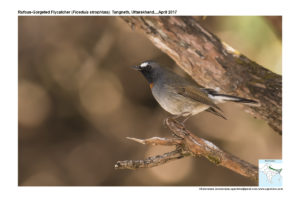Rufous-gorgetted Flycatcher

Rufous-gorgeted Flycatcher Ficedula strophiata
Etymology:
- Ficedula : Latin word ficedula –small fig-eating bird
- Strophiata : Latin Word strophium- breast-band
Vernacular Names: Lepcha: Phatt-tagrak-pho, Nepal: Siphya
Distribution in India: Resident in Himalayas and North East India.
Description: Size of 13-14 cm; wt. of 10-15 g. It is a small to medium-sized forest flycatcher with prominent face pattern, rufous patch on breast and white patches at base of tail. Male of nominate race has white on forehead extending narrowly over lores to above eye, black cheek, chin and throat, deep grey forecrown, ear-coverts and side of neck; rear crown hind neck and upperparts, including upperwing, olive-brown, tertials and inner secondaries edged warm brown; uppertail-coverts dark grey or blackish, becoming black on tail, except for broad white bases of all outer rectrices; center of upper breast bright rufous , bordered by grey on breast side and lower breast, flanks buffish, belly to undertail-coverts whitish; iris brown; bill black; legs dark grey or black. Female is similar to male, but has less distinct white on forehead to over eye, paler face pattern, duller orange patch on upper breast, and slate-grey center of lower breast. Flirts and spreads tail when alarmed. The juvenile has head, upperparts and underparts heavily spotted with buff, spots on scapulars are fringed darker, breast and flanks are barred or scalloped with darker fringes, flight-feathers and tail are as adult.
Habitat:It is found in dense or open broadleaf forest, mixed conifer and broadleaf forest, and thick secondary scrub and edges; breeds at 2440–3800 m in Himalayas.
Food Habits: It eats small invertebrates. It is usually solitary or in pairs. It forages in undergrowth, occasionally on ground and in lower and middle levels of forest trees. Generally inconspicuous, perching low down, but not shy.
Breeding Habits: They breed in Apr-June in India. The nest is cup-shaped, made of moss, roots and plant fibers, placed up in tree or on ground. It lays a clutch of 3–4 eggs.